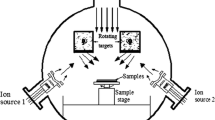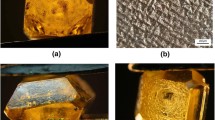Abstract.
One of the most important characteristics and basic phenomena during diamond growth from liquid metal catalyst solutions saturated with carbon at high temperature–high pressure (HPHT) is that there exists a thin metallic film covering on the growing diamond, through which carbon-atom clusters are delivered to the surface of the growing diamond by diffusion. A study of microstructures of such a metallic film and a relation between the thin metallic film and the inclusions trapped in HPHT as-grown diamond single crystals may be helpful to obtain high-purity diamond single crystals. It was found that both the metallic film and the HPHT as-grown diamond single crystals contain some nanostructured regions. Examination by transmission electron microscopy suggests that the microstructure of the thin metallic film is in accordance with nanosized particles contained in HPHT as-grown diamond single crystals. The nanosized particles with several to several tens of nanometers in dimension distribute homogeneously in the metallic film and in the diamond matrix. Generally, the size of the particles in the thin metallic film is relatively larger than that within the diamond matrix. Selected area electron diffraction patterns suggest that the nanosized particles in the metallic film and nanometer inclusions within the diamond are mainly composed of f.c.c. (FeNi)23C6, hexagonal graphite and cubic γ-(FeNi). The formation of the nanosized inclusions within the diamond single crystals is thought not only to relate to the growth process and rapid quenching from high temperature after diamond synthesis, but also to be associated with large amounts of defects in the diamond, because the free energy in these defect areas is very high. The critical size of carbide, γ-(FeNi)and graphite particles within the diamond matrix should decrease and not increase according to thermodynamic theory during quenching from HPHT to room temperature and ambient pressure.
Similar content being viewed by others
Author information
Authors and Affiliations
Additional information
Received: 13 September 2001 / Accepted: 12 June 2002 / Published online: 17 December 2002
RID="*"
ID="*"Corresponding author. Fax: +86-0531/295-5081; E-mail: yinlw@sdu.edu.cn
Rights and permissions
About this article
Cite this article
Yin, LW., Li, MS., Gong, ZG. et al. A relation between a metallic film covering on diamond formed during growth and nanosized inclusions in HPHT as-grown diamond single crystals . Appl Phys A 76, 1061–1065 (2003). https://doi.org/10.1007/s00339-002-1508-3
Issue Date:
DOI: https://doi.org/10.1007/s00339-002-1508-3




